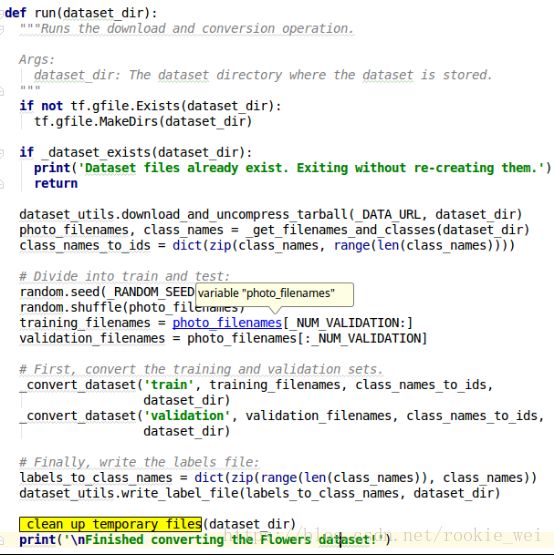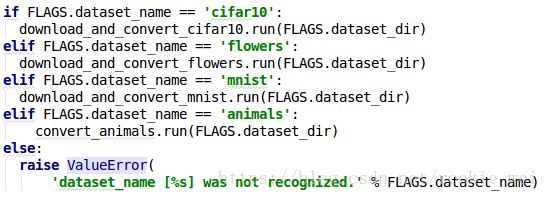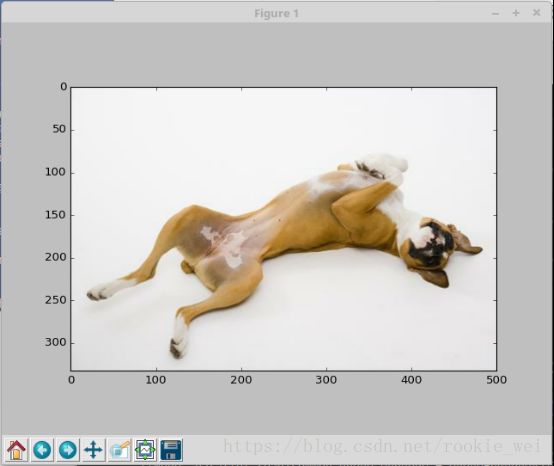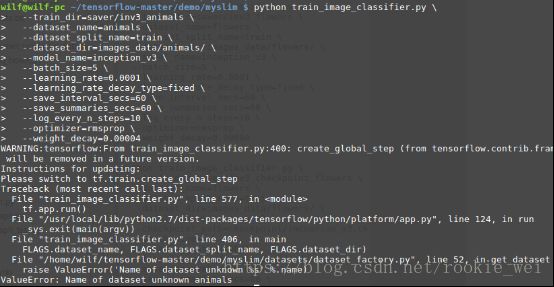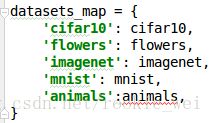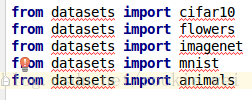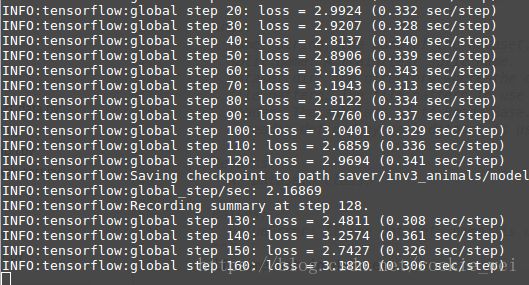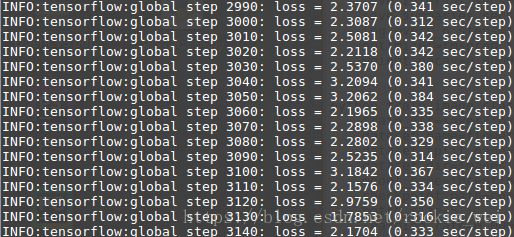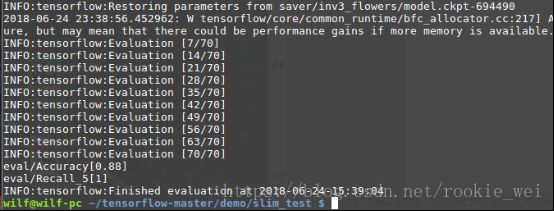tensorflow入门教程(二十)使用slim模型库训练自己的数据
#
#作者:韦访
#博客:https://blog.csdn.net/rookie_wei
#微信:1007895847
#添加微信的备注一下是CSDN的
#欢迎大家一起学习
#
1、概述
上一节,我们使用python3爬取了百度图片的一些图片数据,这一节,我们就使用这些爬取下来的图片,训练我们自己的模型,用来识别猪、蛇、狗、大象、老虎这五种动物。在这里吐嘲一下百度图片搜索结果,真是不敢恭维,前面几页结果相关度还好,越到后面越不准确。所以,要对上一节中下载的图片数据进行筛选,将一些无关的图片删除。
2、将数据集转成TFRecord格式
2.1、模仿slim的Flowers数据集
学习的一大技能就是从模仿开始。第十六讲《tensorflow入门笔记(十六)使用slim模型库对图片分类》讲到,Flowers数据集共有2500张训练图片和2500张测试图片,共5个分类,分别是菊(daisy)、蒲公英(dandelion)、玫瑰(roses)、向日葵(sunflowers)、郁金香(tulips)。原始数据集目录如下图,
每个子文件夹下是对应品种的图片,如daisy,
使用
python download_and_convert_data.py \
--dataset_name=flowers --dataset_dir=images_data/flowers
命令将数据集下载并转成TFRecord格式,所以,我们就从这作为入口,开始模仿。
2.2、整理数据
打开download_and_convert_data.py文件,看到以下代码,
可知,flowers数据集运行的是,download_and_convert_flowers.run(FLAGS.dataset_dir)
打开datasets/download_and_convert_flowers.py文件,看到数据集的URL,
搜索一下变量_DATA_URL,
这里会将这个下载来的数据集删除了?搜索一下_clean_up_temporary_files
函数,
可以看到,处理完数据以后才将原始数据集文件删除的,那么,将
_clean_up_temporary_files(dataset_dir)
注释掉,再运行,我们应该就可以得到原始的数据集了。运行结果如下,
对比第十六讲得到的结果,
跟我们设想的一样,那么,进入flower_photos文件夹看看,
里面有5个文件夹,每个文件夹下有相应的原始图片,
好了,那么我们也模仿它这样排列。
首先回顾一下上一讲我们下载的数据的排列方法,
五个文件下,每个文件下代表一个种类,用相应的英文名做文件名,以Dog文件夹为例,其下的每个子文件夹包含50张相应的图片,总共有40个子文件夹,我们对图片进行筛选以后,每个子文件夹下就不一定有50张图片了,
现在,我们将Dog的子文件夹下的图片剪切到Dog目录下,然后将所有的子文件夹删除。剪切命令如下,
cd Dog
find Dog* -name "*.jpg*" -exec mv {} . \;
其他几个以此类推,得到结构如下,
最后,将它们拷贝到images_data/animals/animals_photos目录下。
2.3、将图片转成TFRecord格式
数据整理好以后,就模仿代码咯,复制download_and_convert_flowers.py并将文件名改为convert_animals.py。修改后的源码如下,
#encoding:utf-8
from __future__ import absolute_import
from __future__ import division
from __future__ import print_function
import math
import os
import random
import sys
import tensorflow as tf
from datasets import dataset_utils
# The URL where the Flowers data can be downloaded.
_DATA_URL = 'http://download.tensorflow.org/example_images/flower_photos.tgz'
# The number of images in the validation set.
_NUM_VALIDATION = 350
# Seed for repeatability.
_RANDOM_SEED = 0
# The number of shards per dataset split.
_NUM_SHARDS = 5
class ImageReader(object):
"""Helper class that provides TensorFlow image coding utilities."""
def __init__(self):
# Initializes function that decodes RGB JPEG data.
self._decode_jpeg_data = tf.placeholder(dtype=tf.string)
self._decode_jpeg = tf.image.decode_jpeg(self._decode_jpeg_data, channels=3)
def read_image_dims(self, sess, image_data):
image = self.decode_jpeg(sess, image_data)
return image.shape[0], image.shape[1]
def decode_jpeg(self, sess, image_data):
image = sess.run(self._decode_jpeg,
feed_dict={self._decode_jpeg_data: image_data})
assert len(image.shape) == 3
assert image.shape[2] == 3
return image
def _get_filenames_and_classes(dataset_dir):
"""Returns a list of filenames and inferred class names.
Args:
dataset_dir: A directory containing a set of subdirectories representing
class names. Each subdirectory should contain PNG or JPG encoded images.
Returns:
A list of image file paths, relative to `dataset_dir` and the list of
subdirectories, representing class names.
"""
#将flower_photos改为animals_photos
flower_root = os.path.join(dataset_dir, 'animals_photos')
directories = []
class_names = []
for filename in os.listdir(flower_root):
path = os.path.join(flower_root, filename)
if os.path.isdir(path):
directories.append(path)
class_names.append(filename)
photo_filenames = []
for directory in directories:
for filename in os.listdir(directory):
path = os.path.join(directory, filename)
photo_filenames.append(path)
return photo_filenames, sorted(class_names)
def _get_dataset_filename(dataset_dir, split_name, shard_id):
#修改文件名,将flowersg改为animals
output_filename = 'animals_%s_%05d-of-%05d.tfrecord' % (
split_name, shard_id, _NUM_SHARDS)
return os.path.join(dataset_dir, output_filename)
def _convert_dataset(split_name, filenames, class_names_to_ids, dataset_dir):
"""Converts the given filenames to a TFRecord dataset.
Args:
split_name: The name of the dataset, either 'train' or 'validation'.
filenames: A list of absolute paths to png or jpg images.
class_names_to_ids: A dictionary from class names (strings) to ids
(integers).
dataset_dir: The directory where the converted datasets are stored.
"""
assert split_name in ['train', 'validation']
num_per_shard = int(math.ceil(len(filenames) / float(_NUM_SHARDS)))
with tf.Graph().as_default():
image_reader = ImageReader()
with tf.Session('') as sess:
for shard_id in range(_NUM_SHARDS):
output_filename = _get_dataset_filename(
dataset_dir, split_name, shard_id)
with tf.python_io.TFRecordWriter(output_filename) as tfrecord_writer:
start_ndx = shard_id * num_per_shard
end_ndx = min((shard_id+1) * num_per_shard, len(filenames))
for i in range(start_ndx, end_ndx):
sys.stdout.write('\r>> Converting image %d/%d shard %d' % (
i+1, len(filenames), shard_id))
sys.stdout.flush()
# Read the filename:
image_data = tf.gfile.FastGFile(filenames[i], 'rb').read()
height, width = image_reader.read_image_dims(sess, image_data)
class_name = os.path.basename(os.path.dirname(filenames[i]))
class_id = class_names_to_ids[class_name]
example = dataset_utils.image_to_tfexample(
image_data, b'jpg', height, width, class_id)
tfrecord_writer.write(example.SerializeToString())
sys.stdout.write('\n')
sys.stdout.flush()
def _clean_up_temporary_files(dataset_dir):
"""Removes temporary files used to create the dataset.
Args:
dataset_dir: The directory where the temporary files are stored.
"""
filename = _DATA_URL.split('/')[-1]
filepath = os.path.join(dataset_dir, filename)
tf.gfile.Remove(filepath)
# 将flower_photos改为animals_photos
tmp_dir = os.path.join(dataset_dir, 'animals_photos')
tf.gfile.DeleteRecursively(tmp_dir)
def _dataset_exists(dataset_dir):
for split_name in ['train', 'validation']:
for shard_id in range(_NUM_SHARDS):
output_filename = _get_dataset_filename(
dataset_dir, split_name, shard_id)
if not tf.gfile.Exists(output_filename):
return False
return True
def run(dataset_dir):
"""Runs the download and conversion operation.
Args:
dataset_dir: The dataset directory where the dataset is stored.
"""
if not tf.gfile.Exists(dataset_dir):
tf.gfile.MakeDirs(dataset_dir)
if _dataset_exists(dataset_dir):
print('Dataset files already exist. Exiting without re-creating them.')
return
#因为我们不需要下载,所以这行注释掉
# dataset_utils.download_and_uncompress_tarball(_DATA_URL, dataset_dir)
photo_filenames, class_names = _get_filenames_and_classes(dataset_dir)
class_names_to_ids = dict(zip(class_names, range(len(class_names))))
# Divide into train and test:
random.seed(_RANDOM_SEED)
random.shuffle(photo_filenames)
training_filenames = photo_filenames[_NUM_VALIDATION:]
validation_filenames = photo_filenames[:_NUM_VALIDATION]
# First, convert the training and validation sets.
_convert_dataset('train', training_filenames, class_names_to_ids,
dataset_dir)
_convert_dataset('validation', validation_filenames, class_names_to_ids,
dataset_dir)
# Finally, write the labels file:
labels_to_class_names = dict(zip(range(len(class_names)), class_names))
dataset_utils.write_label_file(labels_to_class_names, dataset_dir)
#将这行注释掉,要不然转换完以后,原始数据会被删除
# _clean_up_temporary_files(dataset_dir)
print('\nFinished converting the Flowers dataset!')再修改download_and_convert_data.py,添加
from datasets import convert_animals
再在
elif FLAGS.dataset_name == 'mnist':
download_and_convert_mnist.run(FLAGS.dataset_dir)
后添加
elif FLAGS.dataset_name == 'animals':
convert_animals.run(FLAGS.dataset_dir)
如下图所示,
然后运行命令,
python download_and_convert_data.py \
--dataset_name=animals --dataset_dir=images_data/animals
运行结果,
查看目录images_data/animals/,
似乎成功了,已经生成tfrecord文件,接着验证一下,使用第十六讲的方法,从tfrecord文件获取一张图片并显示看看。先来回顾一下第十六讲读取tfrecord的代码,
#encoding:utf-8
from datasets import flowers
import tensorflow as tf
import pylab
import os
os.environ['TF_CPP_MIN_LOG_LEVEL'] = '2'
slim = tf.contrib.slim
#flowers数据集目录
DATA_DIR = 'images_data/flowers/'
#指定获取“validation”下的数据
dataset = flowers.get_split('validation', DATA_DIR)
# Creates a TF-Slim DataProvider which reads the dataset in the background
# during both training and testing.
provider = slim.dataset_data_provider.DatasetDataProvider(dataset)
[image, label] = provider.get(['image', 'label'])
#在session下读取数据,并用pylab显示图片
with tf.Session() as sess:
#初始化变量
sess.run(tf.global_variables_initializer())
#启动队列
tf.train.start_queue_runners()
image_batch,label_batch = sess.run([image, label])
#显示图片
pylab.imshow(image_batch)
pylab.show()
从代码中看到,需要导入from datasets import flowers,
显然我们不能直接用这个,所以,继续模仿。
3、定义datasets文件
将datasets/flowers.py复制并重命名为animals.py ,将
_FILE_PATTERN = 'flowers_%s_*.tfrecord'
改为
_FILE_PATTERN = 'animals_%s_*.tfrecord'
将
SPLITS_TO_SIZES = { 'train': 3320, 'validation': 350}
改为
SPLITS_TO_SIZES = { 'train': 4383, 'validation': 350}
其中,train代表训练的图片张数,validation代表验证使用的图片张数。我们爬取的图片整理以后,只剩下4733张有效图片,验证用了350张,所以训练只有4383张。
完整代码如下,
# Copyright 2016 The TensorFlow Authors. All Rights Reserved.
#
# Licensed under the Apache License, Version 2.0 (the "License");
# you may not use this file except in compliance with the License.
# You may obtain a copy of the License at
#
# http://www.apache.org/licenses/LICENSE-2.0
#
# Unless required by applicable law or agreed to in writing, software
# distributed under the License is distributed on an "AS IS" BASIS,
# WITHOUT WARRANTIES OR CONDITIONS OF ANY KIND, either express or implied.
# See the License for the specific language governing permissions and
# limitations under the License.
# ==============================================================================
"""Provides data for the flowers dataset.
The dataset scripts used to create the dataset can be found at:
tensorflow/models/research/slim/datasets/convert_animals.py
"""
from __future__ import absolute_import
from __future__ import division
from __future__ import print_function
import os
import tensorflow as tf
from datasets import dataset_utils
slim = tf.contrib.slim
_FILE_PATTERN = 'animals_%s_*.tfrecord'
SPLITS_TO_SIZES = {'train': 4383, 'validation': 350}
_NUM_CLASSES = 5
_ITEMS_TO_DESCRIPTIONS = {
'image': 'A color image of varying size.',
'label': 'A single integer between 0 and 4',
}
def get_split(split_name, dataset_dir, file_pattern=None, reader=None):
"""Gets a dataset tuple with instructions for reading flowers.
Args:
split_name: A train/validation split name.
dataset_dir: The base directory of the dataset sources.
file_pattern: The file pattern to use when matching the dataset sources.
It is assumed that the pattern contains a '%s' string so that the split
name can be inserted.
reader: The TensorFlow reader type.
Returns:
A `Dataset` namedtuple.
Raises:
ValueError: if `split_name` is not a valid train/validation split.
"""
if split_name not in SPLITS_TO_SIZES:
raise ValueError('split name %s was not recognized.' % split_name)
if not file_pattern:
file_pattern = _FILE_PATTERN
file_pattern = os.path.join(dataset_dir, file_pattern % split_name)
# Allowing None in the signature so that dataset_factory can use the default.
if reader is None:
reader = tf.TFRecordReader
keys_to_features = {
'image/encoded': tf.FixedLenFeature((), tf.string, default_value=''),
'image/format': tf.FixedLenFeature((), tf.string, default_value='png'),
'image/class/label': tf.FixedLenFeature(
[], tf.int64, default_value=tf.zeros([], dtype=tf.int64)),
}
items_to_handlers = {
'image': slim.tfexample_decoder.Image(),
'label': slim.tfexample_decoder.Tensor('image/class/label'),
}
decoder = slim.tfexample_decoder.TFExampleDecoder(
keys_to_features, items_to_handlers)
labels_to_names = None
if dataset_utils.has_labels(dataset_dir):
labels_to_names = dataset_utils.read_label_file(dataset_dir)
return slim.dataset.Dataset(
data_sources=file_pattern,
reader=reader,
decoder=decoder,
num_samples=SPLITS_TO_SIZES[split_name],
items_to_descriptions=_ITEMS_TO_DESCRIPTIONS,
num_classes=_NUM_CLASSES,
labels_to_names=labels_to_names)所以,将读取tfrecord的代码的改为以下代码,
#encoding:utf-8
from datasets import animals
import tensorflow as tf
import pylab
import os
os.environ['TF_CPP_MIN_LOG_LEVEL'] = '2'
slim = tf.contrib.slim
#flowers数据集目录
DATA_DIR = 'images_data/animals/'
#指定获取“validation”下的数据
dataset = animals.get_split('validation', DATA_DIR)
# Creates a TF-Slim DataProvider which reads the dataset in the background
# during both training and testing.
provider = slim.dataset_data_provider.DatasetDataProvider(dataset)
[image, label] = provider.get(['image', 'label'])
#在session下读取数据,并用pylab显示图片
with tf.Session() as sess:
#初始化变量
sess.run(tf.global_variables_initializer())
#启动队列
tf.train.start_queue_runners()
image_batch,label_batch = sess.run([image, label])
#显示图片
pylab.imshow(image_batch)
pylab.show()运行得到结果为:
说明,我们的TFRecord格式转换正确。
4、开始训练
接下来还要改哪里呢?不好意思,我也不知道,那么,试着运行训练的命令看看咯?执行以下命令看看有什么提示再说。
python train_image_classifier.py \
--train_dir=saver/inv3_animals \
--dataset_name=animals \
--dataset_split_name=train \
--dataset_dir=images_data/animals/ \
--model_name=inception_v3 \
--batch_size=5 \
--learning_rate=0.0001 \
--learning_rate_decay_type=fixed \
--save_interval_secs=60 \
--save_summaries_secs=60 \
--log_every_n_steps=10 \
--optimizer=rmsprop \
--weight_decay=0.00004
运行结果,
很不幸,没有通过,看提示。datasets/dataset_factory.py文件下的get_dataset函数,看看做了什么?
如果name不在datasets_map里就打印错误,那么看看这个datasets_map里是什么?
似乎就是我们数据集的名称,我们将animals加上去试试,改成
编辑工具提示animals有错误,网上搜索flowers看看,
说明这里还需要导包,
所以,改为,
再运行看看,运行结果,
可以看到,我们的模型就这样开始训练了,很简单啊~~~
我靠,得意得太早了,马上出错,来看看报什么错。
INFO:tensorflow:Error reported to Coordinator:
图片的长度必须包含3个元素?那就是有可能有些图片不是RGB格式咯。所以,先找到这些不是RGB格式的图片,用其他图片替换掉它们,或者删除它们,或者将它们转成RGB格式。
作为程序猿,当然不可能手动去找啦,查找非RGB格式图片代码如下,
#encoding:utf-8
from PIL import Image
import os
def get_not_rgb_images(rootdir):
list = os.listdir(rootdir)
for i in range(0, len(list)):
filename = os.path.join(rootdir, list[i])
# print(filename)
if os.path.isfile(filename):
img = Image.open(filename)
pixels = img.getpixel((0, 0))
if type(pixels) == int:
print('单通道:' + filename)
elif type(pixels) == tuple:
if len(pixels) != 3:
print('非RGB的多通道:' +filename)
else:
get_not_rgb_images(filename)
if __name__ == '__main__':
rootdir = 'images_data/animals/animals_photos/'
get_not_rgb_images(rootdir)运行结果:
只有一个文件,那随便下载一张图片将其替换掉好了。替换以后,再运行一下代码检查一下是否还有不是RGB格式的图片,没有的话,删除原来的TFRecord文件,再运行下面命令重新将数据集转成TFRecord格式。
python download_and_convert_data.py --dataset_name=animals --dataset_dir=images_data/animals
再运行训练的命令,
python train_image_classifier.py \
--train_dir=saver/inv3_animals \
--dataset_name=animals \
--dataset_split_name=train \
--dataset_dir=images_data/animals/ \
--model_name=inception_v3 \
--batch_size=5 \
--learning_rate=0.0001 \
--learning_rate_decay_type=fixed \
--save_interval_secs=60 \
--save_summaries_secs=60 \
--log_every_n_steps=10 \
--optimizer=rmsprop \
--weight_decay=0.00004
去洗个澡回来再看看有没有出错~
好了,洗澡回来,程序没出错,
5、第十六讲训练结果
这里插讲一下第十六讲的训练结果,地十六讲中,我们只训练几百步,所以得到的准确率并不高,后来我又加大训练次数,从头开始训练的模型,我训练了694490步,得到的准确率如下,
微调的模型我训练了542700步,准确率如下,
总结:
TFRecord的具体格式怎么样,它怎么存储数据的,我们现在处于初学阶段,并不需要去深究,等以后需要去了解的时候再去学,现在要做的,是大概将一些tensorflow主流的示例都学一遍。下一讲,我们继续往下学习,学习深度学习中的目标检测。
如果您感觉本篇博客对您有帮助,请打开支付宝,领个红包支持一下,祝您扫到99元,谢谢~~
![]()



